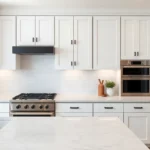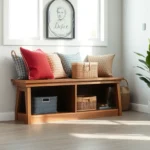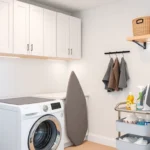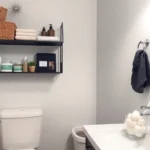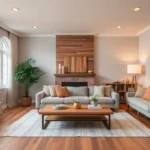We’ve all walked into a living room and immediately felt something was missing. That empty corner begging for life or that bare coffee table screaming for a natural touch. The secret ingredient? Indoor plants that transform your space from ordinary to extraordinary.
Living rooms are where we spend most of our time – entertaining guests, relaxing after long days, and creating memories with family. Strategic plant placement doesn’t just fill empty spaces; it purifies the air we breathe, reduces stress levels, and creates that Instagram-worthy aesthetic we’re all craving.
Whether you’re dealing with low-light conditions, have zero gardening experience, or want to make a bold statement with dramatic foliage, we’ve got you covered. From low-maintenance succulents to stunning fiddle leaf figs, the perfect plant combination is waiting to breathe new life into your living room and create the sanctuary you deserve.
Choose Low-Light Plants for Darker Living Rooms
When your living space lacks abundant natural light, selecting the right plants becomes crucial for maintaining that vibrant atmosphere we discussed earlier. These resilient varieties thrive in dimmer conditions while continuing to purify your air and enhance your room’s aesthetic appeal.
Snake Plants for Corner Spaces
Snake plants excel in low light conditions and transform neglected corners into striking focal points. We recommend placing these architectural beauties in areas that receive minimal sunlight, as they can survive on just artificial lighting from lamps or overhead fixtures.
Their upright, sword-like leaves create dramatic vertical lines that complement modern furniture arrangements. You’ll find varieties like Sansevieria trifasciata ‘Laurentii’ with golden edges or the darker Sansevieria ‘Black Gold’ perfect for adding sophisticated contrast to neutral color schemes.
These plants require watering only every 2-3 weeks, making them ideal if you’re new to plant parenthood or frequently travel. Position them in decorative planters near reading chairs or entertainment centers where their sculptural form can be appreciated without demanding daily attention.
Pothos Vines for Hanging Displays
Pothos varieties bring cascading greenery to spaces where floor plants won’t fit or receive adequate light. We suggest hanging these trailing beauties from ceiling hooks or placing them on high shelves where their vines can drape gracefully downward.
Golden pothos, marble queen, and neon varieties each offer unique leaf patterns and colors that brighten dark rooms naturally. Their heart-shaped leaves catch and reflect whatever light is available, creating movement and visual interest at eye level.
You can train pothos vines along walls using small hooks or let them cascade freely from macrame hangers for a bohemian touch. These adaptable plants grow in water or soil, allowing you to propagate cuttings easily and expand your collection throughout your living room.
ZZ Plants for Modern Aesthetics
ZZ plants deliver contemporary style with their glossy, dark green leaves that seem to glow even in minimal lighting conditions. We find their symmetrical growth pattern and waxy texture perfectly complement sleek furniture and minimalist decor themes.
Their thick, upright stems support pairs of oval leaflets that create clean geometric patterns against walls or beside modern sofas. Zamioculcas zamiifolia can tolerate extremely low light levels and irregular watering schedules, making them practically indestructible for busy lifestyles.
Place ZZ plants in decorative ceramic pots near coffee tables or as bookshelf companions where their compact size won’t overwhelm smaller spaces. These plants grow slowly and maintain their shape without frequent pruning, offering long-term beauty with minimal maintenance requirements.
Select Statement Plants as Living Room Focal Points

Statement plants serve as living sculptures that command attention and anchor your room’s design scheme. These impressive specimens transform ordinary spaces into extraordinary sanctuaries while showcasing your personal style.
Fiddle Leaf Figs for Height and Drama
Fiddle Leaf Figs create instant sophistication with their towering presence and glossy, violin shaped leaves. We recommend positioning these dramatic beauties near bright windows where they’ll receive consistent indirect sunlight throughout the day.
Watering becomes crucial for these temperamental giants since they prefer consistent moisture without becoming waterlogged. Their impressive height potential of 6 to 10 feet indoors makes them perfect corner companions that fill vertical space beautifully.
Glossy foliage reflects natural light around your living room while adding architectural interest to empty corners. We’ve found that rotating them weekly prevents leaning toward light sources and maintains their symmetrical growth pattern.
Monstera Deliciosa for Tropical Vibes
Monstera Deliciosa brings exotic charm through its distinctive fenestrated leaves that develop unique holes and splits as the plant matures. These tropical showstoppers thrive in bright, indirect light conditions while requiring moderate watering schedules.
Split leaves create natural artwork that changes as your plant grows larger and more impressive over time. We love how these climbing plants add vertical interest when provided with moss poles or trellises for support.
Tropical aesthetics emerge naturally as glossy green foliage spreads across your living space with minimal maintenance requirements. Air purifying qualities make these beauties functional focal points that improve your indoor environment while serving as conversation starters.
Bird of Paradise for Bold Design
Bird of Paradise plants make striking statements with their paddle shaped leaves and potential for exotic orange and blue blooms indoors. These bold specimens prefer bright light conditions and regular watering to maintain their impressive stature.
Exotic flowers resembling colorful bird beaks emerge from mature plants that receive adequate sunlight and proper care. We recommend placing these tropical giants near south facing windows where they’ll receive 6 to 8 hours of bright light daily.
Dramatic foliage creates instant vacation vibes while reaching heights of 4 to 6 feet in indoor conditions. Large leaves may split naturally in response to wind or low humidity, adding authentic tropical character to your living room design.
Create Plant Groupings for Visual Impact
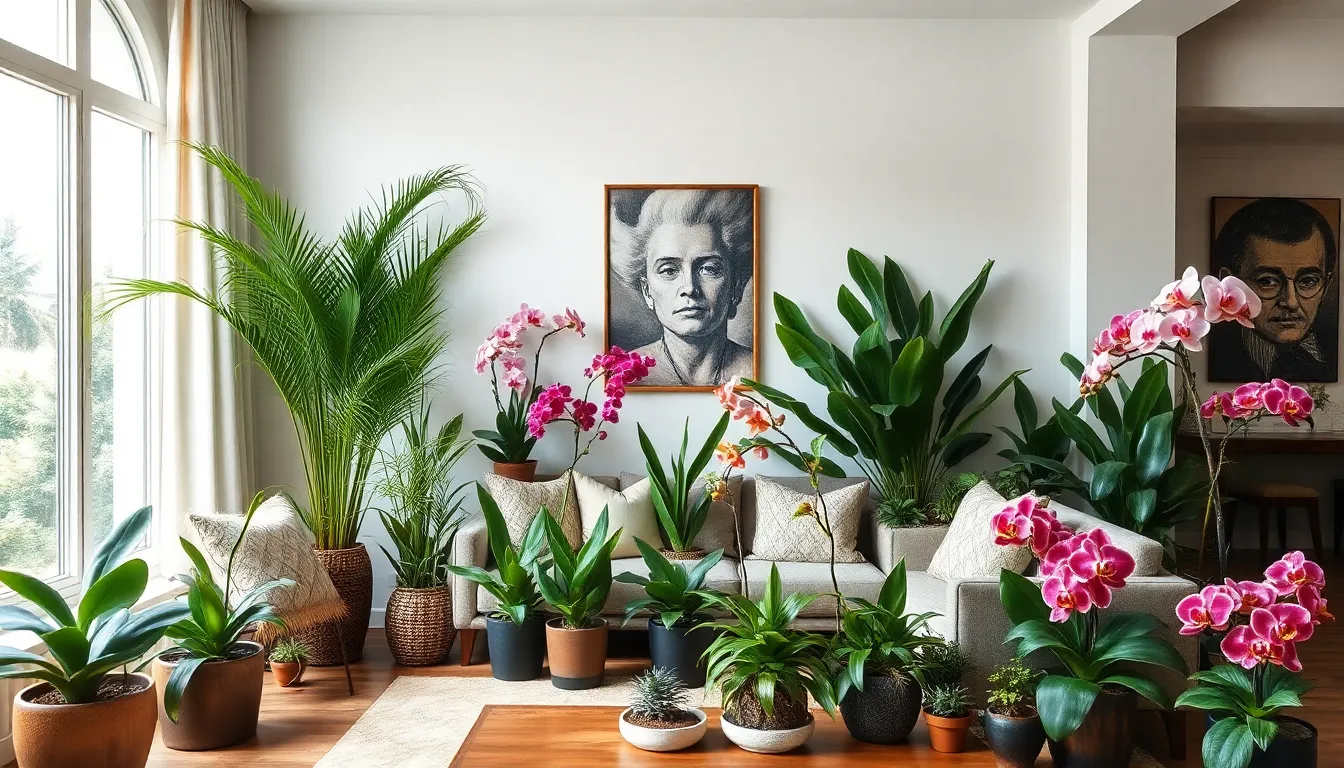
Grouping plants together transforms your living room into a cohesive botanical display that draws the eye and creates natural focal points. We recommend selecting plants of varying sizes and shapes to achieve the most striking visual arrangements that complement your existing decor.
Mix Different Heights and Textures
Layering creates dimensional interest when we combine tall floor plants with medium and small specimens throughout our living spaces. Areca Palms provide excellent vertical elements alongside Umbrella Plants, while smaller textured options like succulents and ferns add complexity at lower levels. We’ve found that contrasting smooth leaves with feathery fronds or waxy surfaces with fuzzy textures enhances the overall visual appeal of our plant collections.
Use Odd Numbers for Better Composition
Odd numbered groupings naturally create more ever-changing and visually pleasing arrangements than their even numbered counterparts. We suggest clustering three or five plants together to achieve this balanced asymmetry that feels organic and intentional. Positioning a tall Areca Palm with two smaller companions like String of Pearls demonstrates this principle effectively while maintaining visual harmony throughout the space.
Combine Flowering and Foliage Plants
Mixing colorful blooms with lush greenery adds seasonal interest and prevents our living room displays from appearing monotonous. Flowering varieties such as orchids and African Violets provide vibrant color bursts that complement the steady green presence of foliage plants like Umbrella Plants and ferns. We recommend maintaining a ratio that favors foliage plants to ensure our arrangements remain cohesive year round, even when blooming cycles end.
Incorporate Air-Purifying Plants for Health Benefits
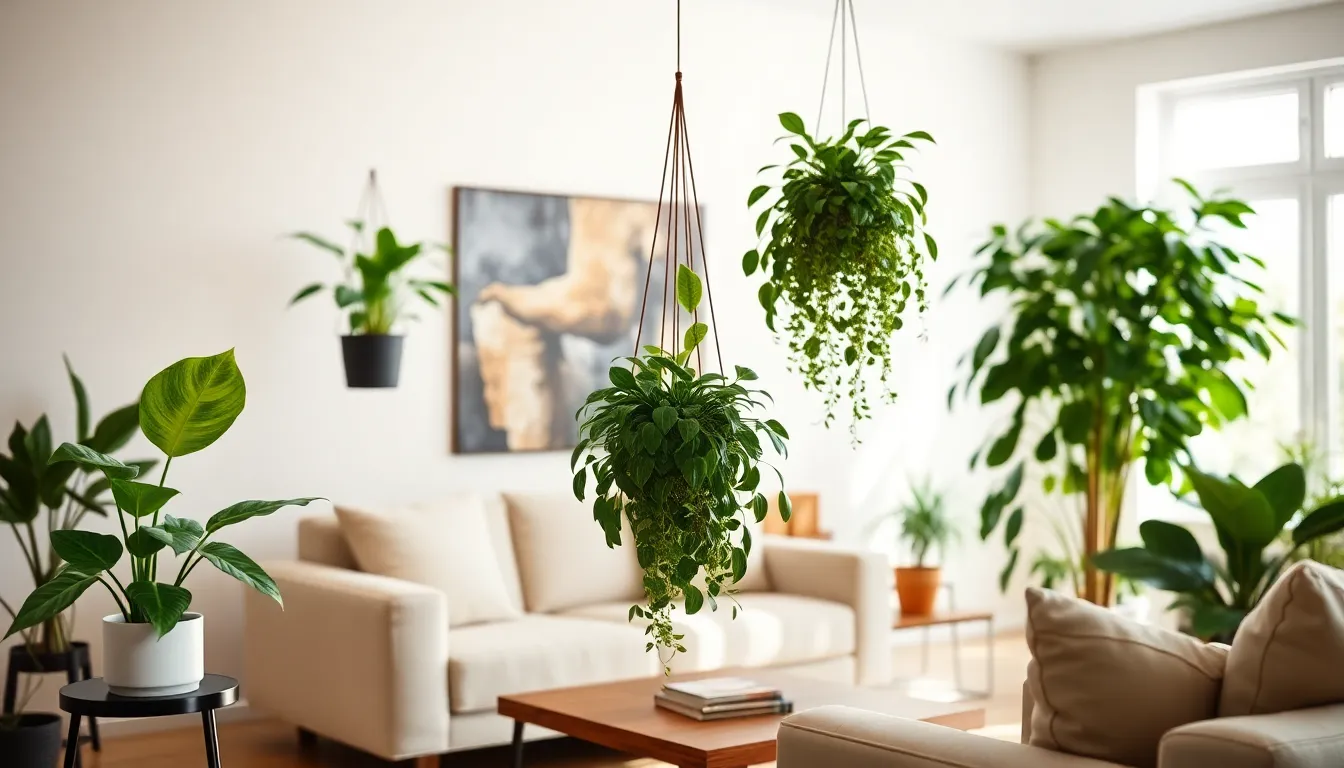
We’ve selected these plants not just for their beauty but for their proven ability to remove harmful toxins from your living room air while adding natural elegance to your space.
Peace Lilies for Clean Air and Elegance
Peace lilies transform your living room with their stunning white blooms while actively removing formaldehyde and benzene from the air. These sophisticated plants thrive in well-draining soil and adapt beautifully to medium or low light conditions, making them perfect for spaces without direct sunlight. We love how their glossy green leaves create a striking backdrop for the elegant white flowers that bloom throughout the year. Care requirements remain minimal as these plants signal when they need water by drooping slightly, then perk up within hours of watering. Placement near a coffee table or side table allows their air-purifying benefits to work most effectively in your primary seating area.
Spider Plants for Easy Maintenance
Spider plants excel as beginner-friendly air purifiers that remove formaldehyde and xylene while producing charming plantlets for propagation. These resilient plants thrive in bright, indirect light and can be grown in various pot sizes to fit any corner or shelf in your living room. We recommend hanging spider plants to showcase their cascading baby plants, which create natural living curtains that filter air as they grow. Propagation becomes incredibly simple as you can root the plantlets in water or soil, allowing you to expand your collection or share with friends. Maintenance involves occasional watering when the soil feels dry and periodic removal of brown leaf tips to keep them looking fresh.
Rubber Trees for Large Spaces
Rubber trees make impressive statements in spacious living rooms with their large, dark green leaves that effectively purify indoor air. These substantial plants prefer bright, indirect light and need regular watering to maintain their glossy foliage and robust growth. We suggest positioning rubber trees in corners where their vertical growth won’t overwhelm furniture while their broad leaves can process maximum air volume. Growth patterns allow these plants to reach impressive heights indoors, creating natural room dividers or backdrop elements for seating arrangements. Care involves wiping leaves monthly to remove dust buildup and ensure optimal air purification performance.
Design with Hanging and Trailing Plants

Hanging and trailing plants transform living rooms by adding vertical dimension and natural movement to your space. These versatile plants create stunning focal points while maximizing floor space.
Macrame Hangers for Bohemian Style
Macrame plant hangers instantly infuse your living room with vintage bohemian charm and artistic flair. We recommend suspending these handcrafted holders from ceiling hooks or mounting them directly to walls for maximum visual impact.
String of Pearls (Senecio rowleyanus) creates the most dramatic cascading effect when displayed in macrame hangers. The distinctive bead-like foliage spills gracefully over the edges, forming living curtains that catch the eye from every angle.
English Ivy thrives in macrame displays and produces lush trailing vines that can extend several feet in length. Boston Ferns also work beautifully in these woven holders, creating full, textured displays that soften hard architectural lines.
Position macrame hangers at varying heights to establish visual layers throughout your living room. Mix different macrame styles and cord colors to complement your existing decor while maintaining that coveted bohemian aesthetic.
Wall-Mounted Planters for Space Saving
Wall-mounted planters optimize vertical space in compact living rooms without sacrificing style or greenery. These space-saving answers work particularly well in apartments or smaller homes where floor space comes at a premium.
Geogenanthus and Pink Polka Dot Plants excel in wall-mounted containers due to their compact growth habits and stunning foliage patterns. These plants won’t overwhelm smaller planters while still providing impressive visual appeal.
Pothos varieties cascade beautifully from wall planters, creating living artwork that changes as the vines grow longer. We suggest installing planters at eye level or slightly above to showcase the trailing growth patterns effectively.
Align your wall planters with existing furniture lines or architectural features to maintain visual cohesion. Consider creating gallery walls that combine planters with artwork for a sophisticated, curated appearance.
Ceiling Hooks for Cascading Effects
Ceiling hooks create the most dramatic cascading plant displays by allowing long trailing species to reach their full potential. Install heavy-duty hooks that can support the weight of mature plants plus their containers and soil.
Trailing Philodendron produces some of the longest, most impressive cascades when hung from ceiling hooks. These fast-growing plants can develop vines that reach floor length, creating stunning natural room dividers or corner features.
String of Pearls works exceptionally well with ceiling installations, as the delicate pearl-like strands create ethereal, flowing displays that seem to float in space. Position these plants where they won’t be disturbed by foot traffic but can still be admired from multiple angles.
Balance your ceiling-hung arrangement by installing plants at different heights and spacing them strategically throughout the room. Layer various trailing species to create depth and visual interest that draws the eye upward and makes your living room feel larger and more ever-changing.
Utilize Floor Plants for Ground-Level Interest
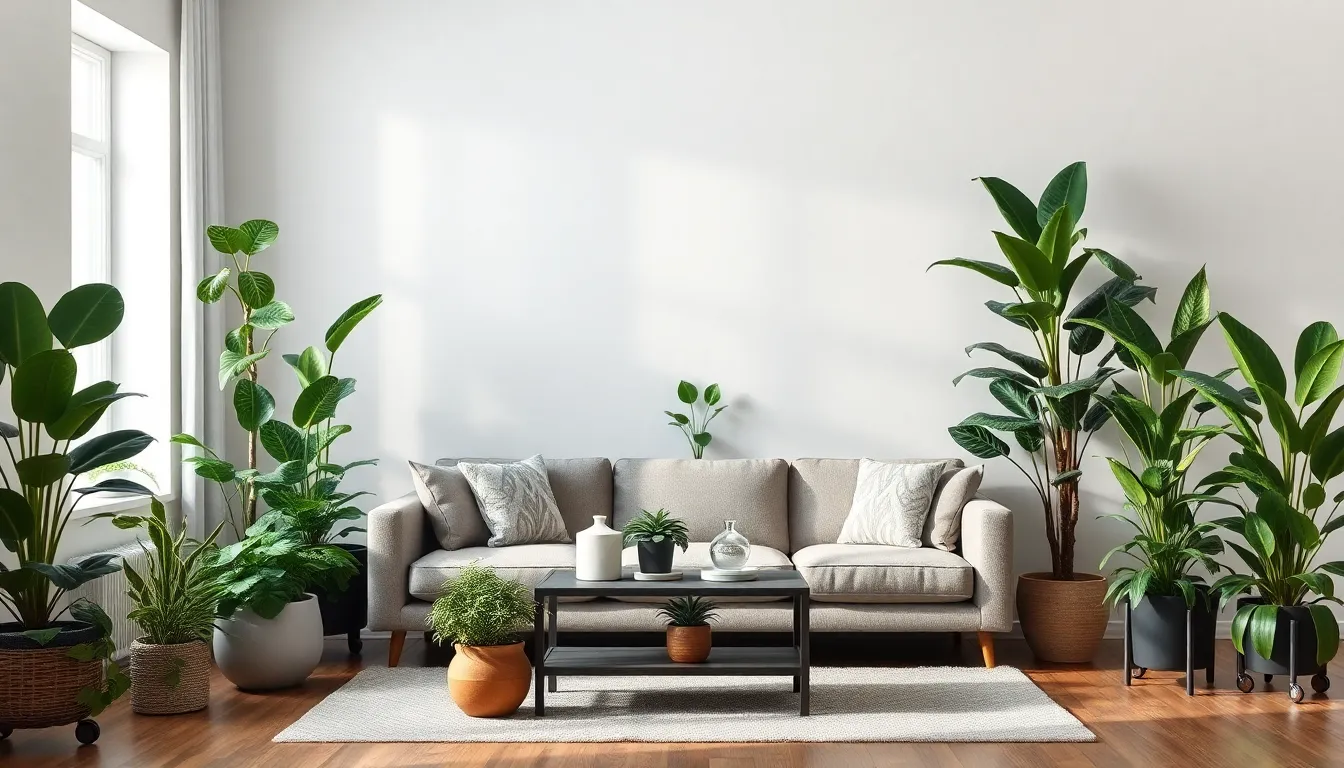
Floor plants bring natural beauty directly to your living room’s foundation while creating impressive visual anchors that complement wall-mounted and hanging varieties. We recommend selecting specimens that range from 3 to 6 feet in height to establish proper scale without overwhelming your space.
Large Planters as Room Dividers
Large planters function as elegant room dividers that maintain visual flow while defining separate areas within your living space. We suggest positioning substantial containers with plants like Fiddle Leaf Fig Trees, which can reach 5½ to 6½ feet tall, to naturally separate seating areas from dining spaces or home offices. Strategic placement allows you to create intimate conversation zones without installing permanent walls or bulky furniture pieces.
Tropical specimens such as palms and philodendrons work exceptionally well in oversized planters because their broad foliage creates effective visual barriers. We find that these living dividers offer flexibility that traditional room separators can’t match, allowing light to filter through while maintaining distinct functional areas.
Corner Plants to Fill Empty Spaces
Corner plants transform neglected spaces into vibrant focal points that draw the eye upward and outward. Dracaena Lisa serves as an ideal corner specimen because it grows tall without requiring extensive floor space, making it perfect for tight areas that need vertical interest. We recommend this variety for corners that receive moderate to low light conditions.
Monstera and Schefflera Arboricola thrive in corner placements where they can spread their distinctive foliage without interfering with foot traffic. These plants adapt well to less spacious environments while providing the lush greenery that makes corners feel intentionally designed rather than forgotten.
Wheeled Planters for Flexibility
Wheeled planters offer unmatched versatility for plant enthusiasts who want to optimize growing conditions while maintaining design flexibility. We use mobile containers to follow seasonal light patterns, ensuring plants like Philodendron Jungle Boogie receive the exact light intensities they require throughout the year.
Moving plants becomes effortless when you need to rearrange furniture for entertaining or cleaning. Wheeled systems allow us to experiment with different layouts until we find the perfect configuration for both plant health and room aesthetics. This mobility proves especially valuable for specimens that benefit from rotating positions to achieve even growth patterns.
Match Plant Containers to Your Decor Style

We can transform our living room plants into seamless design elements by selecting containers that complement our interior aesthetic. The right planters bridge the gap between natural greenery and our home’s overall design theme.
Modern Ceramic Pots for Contemporary Homes
Modern ceramic pots deliver sleek sophistication that perfectly suits contemporary living spaces. These containers feature clean lines and minimalist shapes that won’t compete with our furniture or architectural elements. We’ll find them available in neutral tones like white, gray, and black, plus bold accent colors that can tie into our existing color palette.
Contemporary ceramic planters work exceptionally well with our statement plants like fiddle leaf figs or snake plants. Their smooth surfaces reflect light beautifully, adding visual interest without overwhelming the space. Many modern ceramic options include drainage saucers that maintain the clean aesthetic while protecting our floors.
Wicker Baskets for Rustic Charm
Wicker baskets bring organic warmth that creates cozy, inviting atmospheres in our living rooms. These natural containers add texture and visual depth while maintaining an effortless, lived-in feel. We can choose from various weaving patterns and sizes to match our rustic or bohemian decor themes.
Natural wicker works beautifully with our trailing plants and larger floor specimens. The breathable material allows for proper air circulation around plant roots, making these containers both functional and decorative. We’ll appreciate how wicker baskets soften hard edges in our rooms while creating that coveted farmhouse or organic modern look.
Metallic Planters for Industrial Looks
Metallic planters provide the perfect foundation for industrial and minimalist living room designs. These containers feature brushed steel, copper, or matte black finishes that complement exposed brick, concrete, and metal furniture elements. We can select geometric shapes that echo the angular lines common in industrial decor.
Industrial-style metal planters pair exceptionally well with our architectural plants like ZZ plants or rubber trees. The contrast between organic plant forms and structured metal containers creates ever-changing visual tension. These durable planters resist wear and maintain their sleek appearance, making them ideal for high-traffic living areas where we entertain frequently.
Position Plants for Optimal Growth and Aesthetics
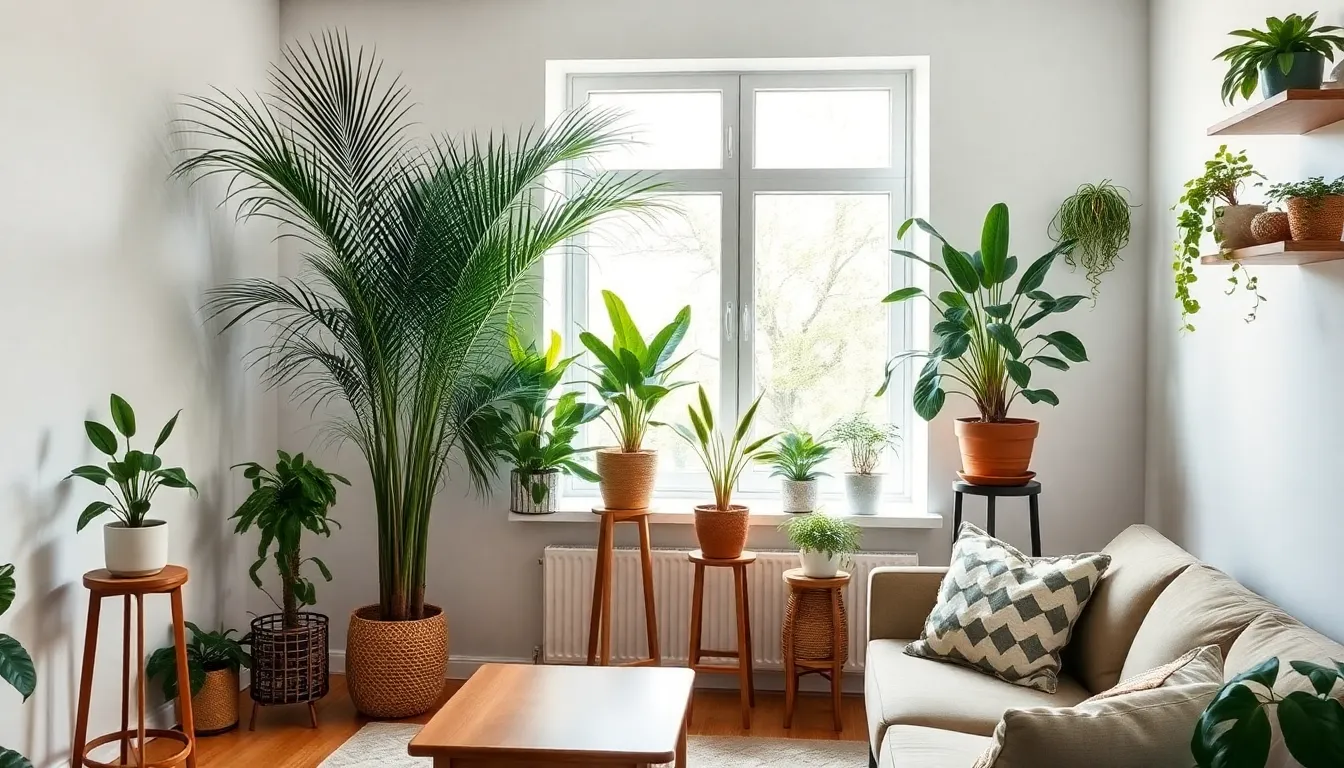
Strategic placement transforms ordinary indoor plants into stunning focal points while ensuring they thrive in your living room environment. Successful positioning requires balancing aesthetic appeal with each plant’s unique growth requirements.
Near Windows for Natural Light
Windows provide the essential natural light that indoor plants need for photosynthesis and healthy development. Spider Plants and Dracaena Compacta flourish in these bright, indirect light conditions, making windowsills their perfect home. We recommend positioning larger plants adjacent to windows rather than directly on sills to maximize light exposure without blocking your view.
East and north facing windows offer gentle morning light that won’t scorch delicate leaves. Southern exposures deliver intense afternoon sun that suits hardy varieties like succulents and cacti. Consider rotating plants weekly to ensure even growth and prevent them from leaning toward the light source.
Away from Heat Sources
Heat sources create sudden temperature fluctuations that stress plants and disrupt their natural growing cycles. Heating vents, radiators, and fireplaces generate dry air currents that can quickly dehydrate even the most resilient varieties. We suggest maintaining at least 3 feet of distance between plants and these heat generating appliances.
Air conditioning units also pose similar challenges by creating cold drafts during summer months. Monitor your plants for signs of temperature stress like browning leaf edges or sudden leaf drop. Moving plants just a few feet away from these sources often resolves these issues completely.
At Varying Eye Levels
Creating visual depth requires positioning plants at multiple heights throughout your living room space. Floor plants like the Areca Palm establish strong vertical presence while table level specimens provide mid range interest. Hanging varieties such as String of Pearls add overhead drama that draws the eye upward.
We recommend using plant stands, floating shelves, and ceiling hooks to achieve this layered effect. Grouping plants in odd numbers creates natural looking arrangements that feel organic rather than formal. Consider placing your tallest specimens in corners where they won’t obstruct traffic flow or conversation areas.
Height variation also ensures each plant receives appropriate light levels based on its exact needs. Taller plants can provide natural shade for smaller varieties that prefer indirect light conditions.
Consider Seasonal Plant Rotations
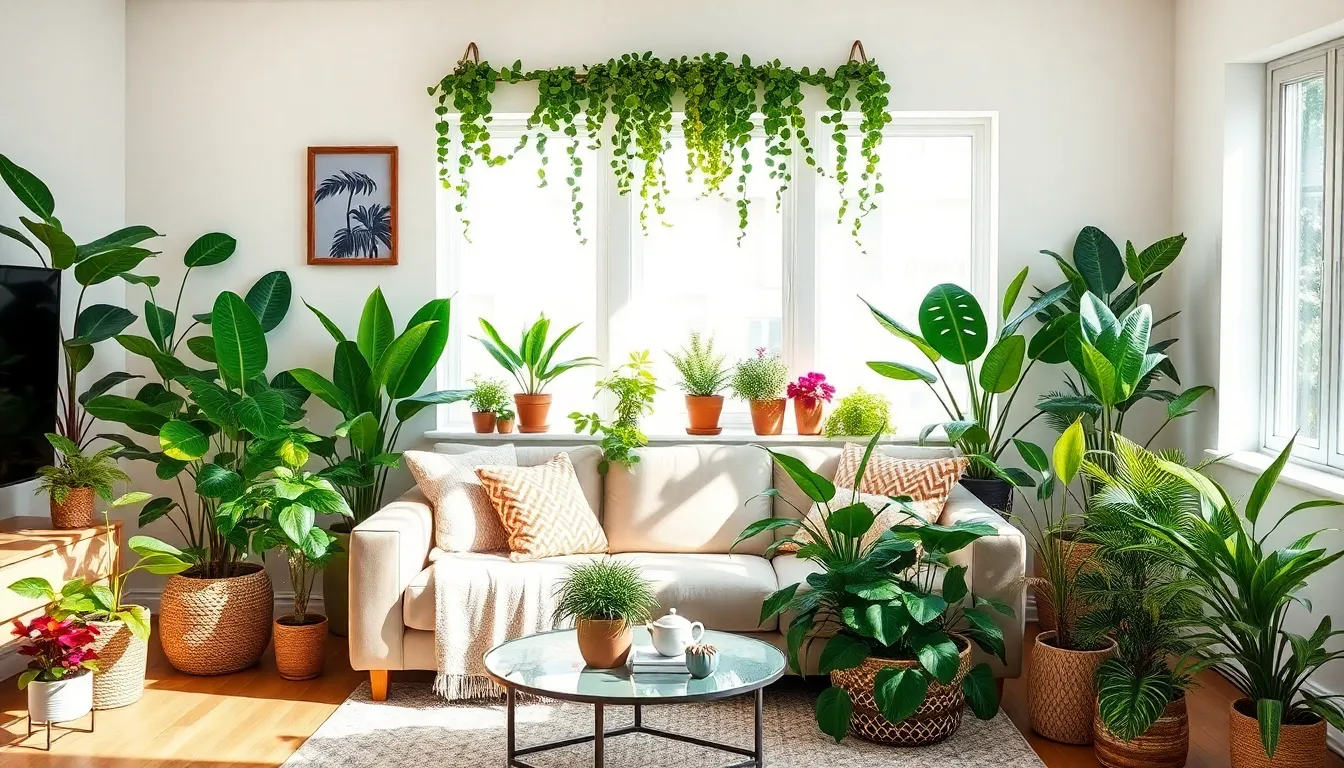
Rotating your indoor plants seasonally keeps your living room feeling fresh and vibrant throughout the year. We’ve curated exact plant selections that thrive during different seasons to maximize both visual appeal and growing success.
Spring Flowering Options
Spring brings renewed energy to our living spaces with flowering plants that celebrate the season’s awakening. Anthurium stands out as our top choice for spring displays, showcasing heart-shaped blooms in vibrant reds, pinks, or whites while maintaining glossy green foliage year-round. These tropical beauties flourish in bright, indirect light and appreciate the higher humidity levels that spring weather naturally provides.
Calathea ‘White Fusion’ adds sophisticated elegance with its stunning variegated leaves that feature cream, white, and green patterns. This prayer plant creates visual interest through its unique foliage movement, folding its leaves upward each evening. Position it near an east-facing window where it’ll receive gentle morning light while staying protected from harsh afternoon sun.
Peace Lily blooms prolifically during spring months, producing elegant white spathes that complement any decor style. We recommend placing these air-purifying champions in spots with consistent moisture and filtered light for optimal flowering performance.
Summer Greenery Displays
Summer calls for lush, tropical plants that create a resort-like atmosphere in our living rooms. Monstera Peru delivers exotic appeal with its thick, textured leaves that develop beautiful fenestrations as they mature. This climbing variety thrives in summer’s brighter light conditions and appreciates the increased humidity from air conditioning systems.
Pothos varieties excel during summer months when their growth accelerates dramatically. Golden Pothos, Marble Queen, and Manjula cultivars cascade beautifully from hanging baskets or climb moss poles with vigor. These versatile plants adapt to various lighting conditions while purifying indoor air throughout the warmer season.
Fiddle Leaf Fig reaches peak growing season during summer, developing new leaves and maintaining its architectural silhouette. Position these statement plants near south-facing windows where they’ll receive ample light to support their large, energy-demanding foliage.
Winter Hardy Varieties
Winter requires plants that tolerate lower light levels and drier indoor air while maintaining their beauty. Norfolk Pine serves as our favorite winter specimen, offering evergreen charm with its symmetrical, tiered branches that resemble miniature Christmas trees. These cold-hardy plants adapt well to reduced daylight hours and cooler room temperatures near windows.
Snake Plant varieties become especially valuable during winter months when many other plants enter dormancy. Sansevieria species tolerate low light, infrequent watering, and temperature fluctuations that come with heating systems cycling on and off.
ZZ Plant maintains its glossy, dark green appearance throughout winter’s challenging conditions. We appreciate how these drought-tolerant specimens continue growing slowly even in reduced light, making them perfect for maintaining greenery when other plants pause their growth cycles.
Conclusion
Transforming your living room with the right indoor plants doesn’t have to be complicated. We’ve shown you how to select plants that match your lighting conditions skill level and design preferences while creating stunning visual displays that improve both air quality and your overall well-being.
The key is starting small and building your collection gradually. Whether you choose low-maintenance succulents for your first attempt or dive straight into statement plants like fiddle leaf figs the most important thing is finding what works for your exact space and lifestyle.
Your living room should reflect your personality and these plant ideas give you countless ways to create a space that’s both beautiful and healthy. With the right combination of plants containers and placement strategies you’ll have a thriving indoor garden that brings joy year-round.
Frequently Asked Questions
What are the best low-light plants for dark living rooms?
Snake plants, pothos vines, and ZZ plants are excellent choices for darker living rooms. These hardy varieties thrive in minimal sunlight and require very little maintenance, making them perfect for beginners. They can tolerate neglect while still providing beautiful greenery to enhance your space’s aesthetics.
Which plants work best as statement pieces in living rooms?
Fiddle leaf figs, Monstera Deliciosa, and Bird of Paradise are ideal statement plants. These large, dramatic specimens serve as living sculptures that anchor your room’s design. Their impressive size and unique foliage create striking focal points that instantly elevate your living space’s visual appeal.
How do I create effective plant groupings for maximum visual impact?
Select plants with varying sizes, heights, and textures to form cohesive displays. Mix different foliage types and combine flowering plants with greenery for seasonal interest. Group plants in odd numbers for a more natural, organic appearance, and ensure taller plants provide shade for smaller varieties that prefer indirect light.
What are the best air-purifying plants for living rooms?
Peace lilies are excellent air purifiers that remove toxins like formaldehyde and benzene while producing elegant white blooms. Spider plants and rubber trees are also effective options that combine air-cleaning abilities with low maintenance requirements, making them perfect for improving indoor air quality.
How can I incorporate hanging and trailing plants effectively?
Use macrame hangers for vintage bohemian charm with plants like String of Pearls and English Ivy. Wall-mounted planters work well in compact spaces, while ceiling hooks create stunning cascading displays. Layer plants at varying heights to add vertical dimension and make your living room feel larger and more dynamic.
What types of planters work best for different decor styles?
Modern ceramic pots complement contemporary homes with sleek sophistication. Wicker baskets add rustic charm and warmth to traditional spaces. Metallic planters work perfectly with industrial designs, providing striking contrast to organic plant forms while maintaining functionality and enhancing your overall aesthetic.
How should I position plants for optimal growth and appearance?
Place plants near windows to maximize natural light, especially varieties like Spider Plants and Dracaena Compacta. Keep plants at least 3 feet away from heat sources to prevent stress and dehydration. Use plant stands, floating shelves, and varying heights to create visual depth and layered effects throughout your space.
Can I rotate plants seasonally to keep my living room fresh?
Yes, seasonal rotations keep spaces vibrant year-round. Choose spring flowering plants like Anthurium and Calathea ‘White Fusion,’ summer tropical varieties like Monstera Peru and Pothos cultivars, and hardy winter options like Norfolk Pine and Snake Plants that tolerate lower light and drier air conditions.


